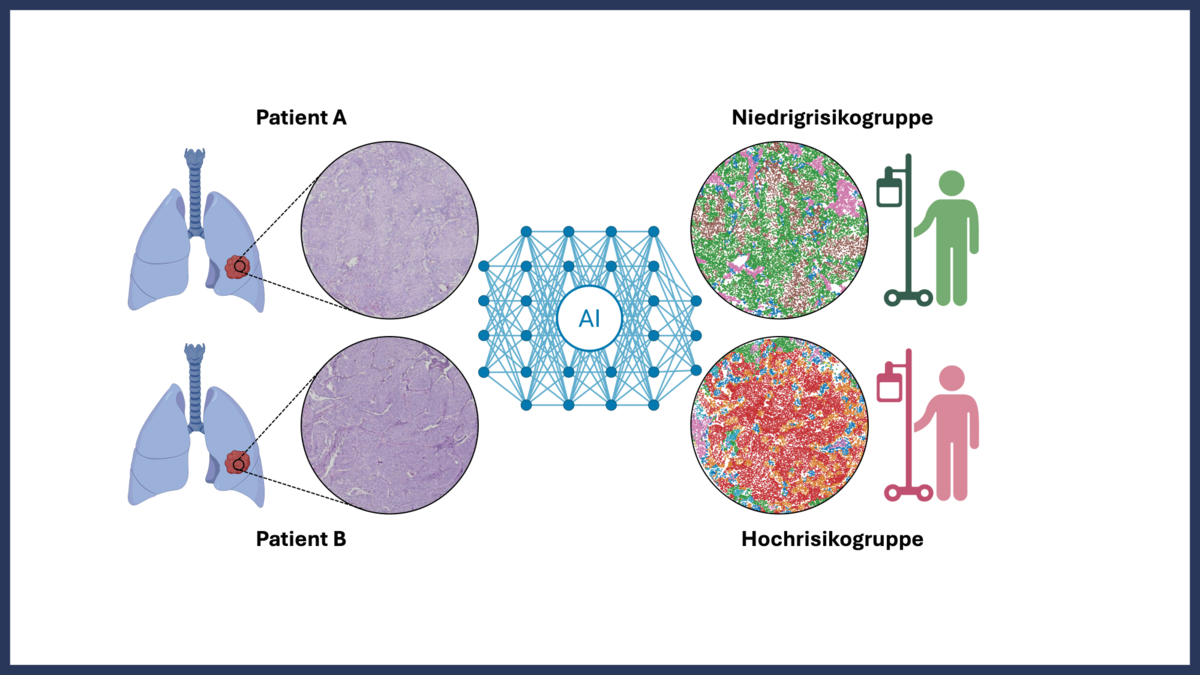Researchers develop new method for risk assessment
An interdisciplinary research team from BIFOLD (Berlin Institute for the Foundations of Learning and Data), Technische Universität Berlin, Universitätsklinikum Köln, Charité - Universitätsmedizin Berlin, the AI company Aignostics, and Ludwig Maximilians University Munich (LMU) has developed a novel AI-based method to more accurately predict the survival of lung cancer patients. The study has now been published in the journal Nature Communications.
In this study, researchers developed a new approach to better estimate the likelihood of recurrence in lung cancer. Until now, such predictions have been based mainly on factors such as tumor size or lymph node involvement, which are often insufficient, especially in early disease stages. This so-called “staging” does not capture the detailed interactions between the tumor and the various cell types of the immune and connective tissue in its surrounding environment. In their work, the researchers combined histological data, multiplex immunofluorescence imaging, and multimodal machine learning to analyze the complex cellular structures and interactions in the tumor microenvironment of 1,168 patients from two major German cancer centers.
Niche patterns provide prognostically relevant information
The scientists were able to characterize 43 different cell types and their spatial relationships within the tumor microenvironment, identifying so-called “cellular niches”, small “neighborhoods” of cells (radius approx. 34 µm) in which the composition of cell types (tumor cells, T and B lymphocytes, macrophages, etc.) was analyzed. By using AI to combine these patterns with established clinical parameters, the researchers achieved a significant improvement in risk stratification.
“AI helps us better understand the spatial organization of cells and the formation of specific cellular niches within tumors, and to translate this knowledge into clinically relevant decisions,” says Associate Professor Dr. Simon Schallenberg, a pathologist at Charité and one of the study’s first authors.
“These niche patterns provide prognostically relevant information in addition to classical staging. We were able to show that the composition of cells in the tumor environment is closely linked to patient survival, particularly in early stages of lung cancer,” explains Prof. Dr. Frederick Klauschen, research group leader at BIFOLD and pathologist at LMU Munich. “Many of these patients can be cured by surgery alone - but not all. Our method now helps identify those at higher risk of recurrence who could benefit from additional adjuvant therapy.”
“Our results show that multimodal, explainable AI can unlock clinically relevant insights from biomedical data that cannot be achieved with conventional methods. The approach combines AI-based image analysis with AI-driven predictive models, is automated, and will be further validated in prospective studies,” says Prof. Dr. Klaus-Robert Müller, BIFOLD Co-director.
This research illustrates how artificial intelligence and modern imaging technologies can jointly provide new insights into tumor biology, laying the groundwork for more precise diagnostics and personalized treatment decisions.
Publication:
Schallenberg S., Dernbach G., et al. (2025): AI-powered spatial cell phenomics enhances risk stratification in non-small-cell lung cancer. Nature Communications 16, 9701.





